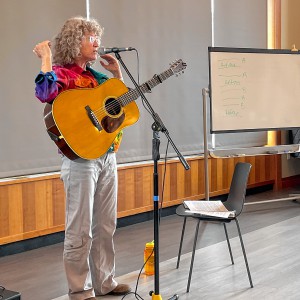GREEN LIVING: Factors for a good foliage season
| Published: 10-23-2022 12:27 PM |
What makes for a stunning fall foliage season? According to retired forestry professor and UNH Cooperative Extension forester Karen Bennett, it has a lot to do with weather.
“So here’s the thing, as long as there’s green leaves on the tree, you have the potential for a really good season,” Bennett said.
But it’s almost impossible to predict what the season will be like before it starts.
“There has been no rigorous scientific study of color quality,” she said. “Therefore, I can only comment based on what we know about biological processes and observations.”
The way foliage season works, Bennett said, “is a convergence of chemistry, biology, physics and psychology.”
In autumn, as the days get shorter, trees stop producing chlorophyll, the green pigment in their leaves. This means other pigments are “unmasked,” some new pigments are produced and the leaves change color.
“We’ve had some really cold nights,” Bennett said. “When the weather is really cold at night, the sugars get trapped in the leaves and are used to make red pigments.”
Those pigments are called anthocyanins. They’re what give fruits and vegetables like blueberries, raspberries, red grapes and eggplants their color. And they’re what give leaves the range of reds and oranges seen in the fall in New Hampshire.
Article continues after...
Yesterday's Most Read Articles
And “when we have really bright, sunny days, it really shows off the colors well,” Bennett said. A bright leaf on a cloudy day won’t appear as striking. Leaves fluoresce on sunny days when light is reflected back at different wavelengths.
There are factors that can impact foliage season, or more generally the health of a tree, earlier in the year, as well. A very wet spring and summer can increase diseases and fungi growth on leaves, which can lead to more brown leaves and less-colorful foliage.
Bennett said, “We had a lot of healthy foliage this year.” There was a moderate drought in the region this summer, but “we must have gotten the rain at the right time,” she said. This helped avoid “leaf scorch,” which is when parts of the leaf or the entire leaf turns brown and shrivels up due to being too dry.
“Dry summer weather may speed the development of the abscission layer,” Bennett said. This is a corky layer of cells that forms between the end of the leaf stem and the branch. It is what eventually causes leaves to fall off of the tree. But “the weather up to and during the season influences the length and quality of the season,” Bennett said.
The peak of this season has ended, but Bennett said there are still quite a lot of trees left with leaves.
“It is nearly inevitable that during the foliage season, there will be a rain and wind event that will end the season by making the leaves fall,” she said.
Another important factor to consider when rating the year’s foliage is human error. The way humans perceive autumn can impact how they feel about the year’s leaves.
“Memory, however imperfect, of past seasons plays an important role in how we perceive the current foliage season,” Bennett said.
It’s unlikely that climate change will alter the timing of foliage season.
“The timing of when leaves change color isn’t weather-dependent. It’s photodependent,” Bennett said, meaning trees stop producing chlorophyll depending on amount of daylight.
However, climate change could increase severe weather, which will be hard on trees. And “if you don’t have healthy leaves on your trees, you’re not going to have the potential for a good foliage season,” Bennett said.
New Hampshire has diverse forests, which can make foliage season more interesting, and it is also beneficial for forest health. During a drought, some tree species are more sensitive than others. Some insects like the emerald ash borer target only ash trees.
“It’s killing ash but we have a lot of other trees that can occupy their space once they’re gone,” Bennett said.
Bennett believes we still have “brilliant and resilient” trees, but she has to wonder, “Will the trees stop recovering?” and if so, when?

 Bernie Watson of Bernie & Louise dies at 80
Bernie Watson of Bernie & Louise dies at 80 Cosy Sheridan speaks and performs for Monadnock Writers’ Group
Cosy Sheridan speaks and performs for Monadnock Writers’ Group ‘The Last Laugh’ coming to Town Hall Theatre in Wilton
‘The Last Laugh’ coming to Town Hall Theatre in Wilton
